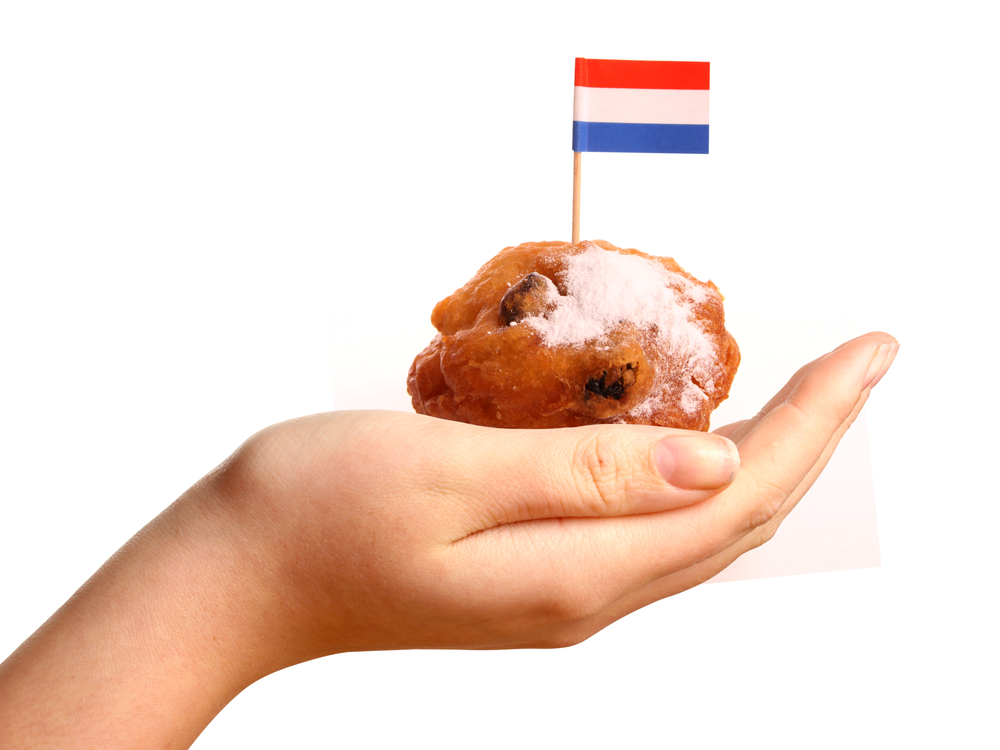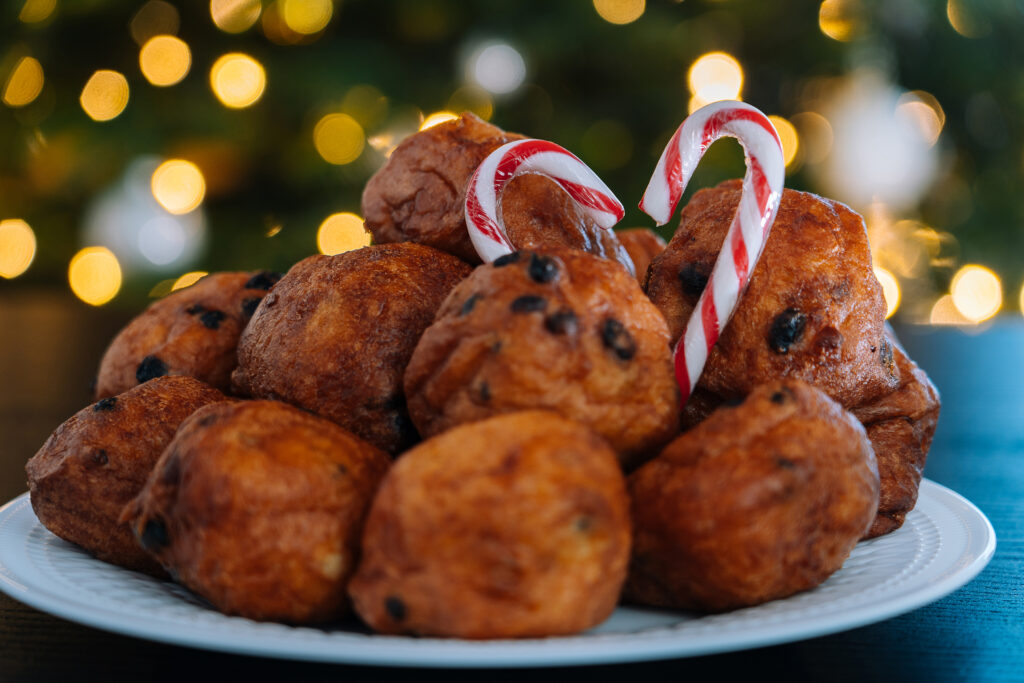As this year draws to a close, millions of oliebollen will be baked and eaten in the Netherlands.
While many tourists and expats get hooked on the oily snack, the interesting questions remain: why do the Dutch eat oliebollen around Christmas and New Year’s Eve? And where did this doughy snack come from?
So while you’re here, grab a drink, a seat, and an oliebol, and let us discuss the delicious Dutch delicacy. 😋
First of all, what are oliebollen?

Oliebollen are small balls of dough that have been fried in a pan with a layer of oil — hence, the (translated) name: oil balls.
This Dutch dessert is usually eaten on New Year’s Eve, with raisins/currants inside or powdered sugar on top. You can also add other ingredients to the batter, such as cinnamon or apple pieces.
READ MORE | Gourmetten: A ‘gezellige’ evening of classic Dutch dining
They are called oliebollen or smoutballen in the Netherlands, smoutebollen in Flanders, croustillons in Wallonia, and schmalzkugeln in Eastern Belgium and Germany.
Origins of the oliebol
The history of the oliebol goes back a long time. Nobody knows who ate the first oliebol, or how they made their way into the low countries.
Die-hard oliebollen fans and experts point to a painting by Albert Cuyp from about 1652 depicting a cooking pot with oliebollen, to show that they have existed for a long time in the Netherlands.
READ MORE | Dutch Quirk #15: cram oliebollen into their mouths as soon as it gets cold
There are some people who believe that the oliebol might have been brought to the Netherlands from Portugal and Spain by Sephardic Jews who were forced to flee from the Spanish Inquisition in the Middle Ages.
At that time, there was already a delicacy in Portugal that looked a lot like an oliebol.

But let’s be honest, none of these facts will convince any Dutchie that the oliebol is not Dutch all the way to its doughy, fatty core.
Batavians and Frisians
Another story goes back even further to a time when the Batavians and the Frisians would eat food made of a kind of fatty dough around the turn of the year in order to escape a Germanic goddess known as Perchta or Berchta.
It was believed that in the winter, she would go around with a sword, ripping open the stomachs of those whose bellies were not fat.
Only those with fat bellies filled with this fatty dough were spared. (So eat up, people! No diets this year 😱.)
So why are oliebollen eaten during the holidays?
There are several theories about why the Dutch eat oliebollen around Christmas and on New Year’s Eve. Some Dutch folks believe that the practice originated in the Middle Ages.
In some areas, it was common for people to fast between St. Martin (November 11) and Christmas. After this period of fasting was over, they feasted, drank and ate.
“Oil cakes” were an important part of this celebration because they were filling and fattening, and thus perfect for the winter period — especially after such a long fast.

In the time between Christmas, New Year’s and Epiphany, it was also a late medieval custom for the poor and vagrants to go door-to-door to get something to eat in exchange for a New Year’s wish or a song.
Oliebollen could have been part of that tradition because they were cheap to make and satisfying.
These days, oliebollen can be bought at small mobile food trucks at train stations all over the country. It is customary to eat them with powdered sugar, and on New Year’s Eve, to wash them down with some champagne.
Some tasty oliebollen facts
- The first recipe for oliebollen, “oil cakes”, can be found in a cookbook from 1667: “De verstandige kock” (the wise cook). Those “oil cakes” were flat, and filled with raisins, apples, and almonds, among other things.
- When Holland became more prosperous in the 17th century and worldwide trade made it easy to obtain olive oil and flour, cakes became thicker and fried in more oil, and that was how the modern-day oliebol was created.
- In 1868 the Dutch dictionary, Van Dale recorded the word “oliebol” and soon after that, the name “oil cake” kind of disappeared.
- There is no word in any other language for “oliebol“. In the United States, they are called “Dutch doughnuts”.
Have you ever tried the oliebol, and what are they called in your country? Tell us your experiences in the comments below!




I’m a second-generation Dutch-Canadian. I was born in Canada; my parents were Dutch post-WWII immigrants. Yes, I’m very familiar with oliebollen. My mother always made them on New Year’s Eve and we would roll them in icing sugar and snack on them until we went to bed on New Year’s Eve. From the late afternoon until 11:00 pm, the house would smell of oil on the stove frying oliebollen. When one of my omas immigrated to Alberta from Amsterdam with her adult daughter in 1953 to where we were living on a dairy farm in northwestern Alberta, she also would make these doughy snacks. My mother usually put raisins in them. As far as I know, they are called oliebollen in Canada, but they are not widely known. Only people with Dutch ancestry know of them and make them for New Years Eve and sometimes other times of the year. My dad also loved them cold on New Years Day, rolled in icing sugar with a cup of coffee, watching the Rose Bowl Parade on TV. I’ve learned, however, by watching cooking shows, that most cultures have a form of oliebollen that they make for celebrations, deep-fried balls of dough.
Another child of Dutch immigrants here. I’ve had them. I’m “meh” on them. Much prefer Bosshe Bollen.
My family’s history goes from the Netherlands, to Prussia and to Russia, and now Canada. We still make them on New Years and they are called Portzeltche. Might be other spelling for the name depending on the region.
We have an adaptation on my rez. The settling families from generations past where of dutch decent and being neighborly they shared the desert with the indigenous neighbors. Have a celebration that is called No:ia we go to house to house on New yrs day Yellin No:ia No:ia (new ya New ya). the person in the house will give Indian Donuts that are actually very similar to oliebollen. i was in highschool when i learned this was a dutch desert because i shared some with some friends who in turned filled me in on the fact their grandparents made a similar treat.